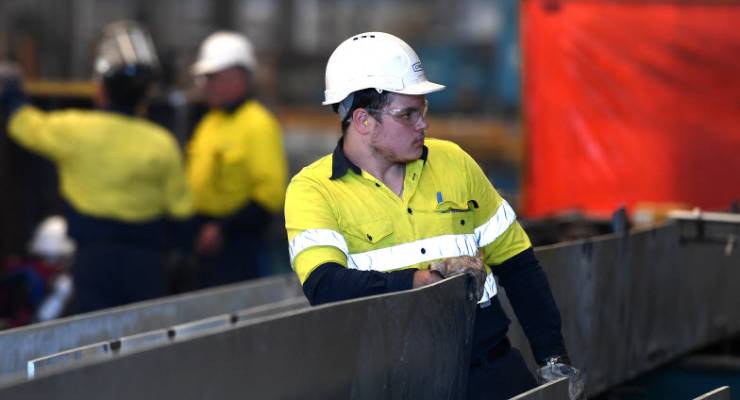
If the government could ever break away from navel-gazing, trying to rip itself apart and working out who is eligible to even be in Parliament, it would have a good story to tell on jobs growth.
Yesterday’s unemployment numbers from the Australian Bureau of Statistics showed that the strong jobs growth that has re-emerged in 2017 continued: 26,000 trend new jobs and 28,000 seasonally adjusted new jobs. Both the trend and seasonally adjusted unemployment rates remained steady at 5.6%, with the labour force participation rate also steady at 65% for the trend data and 65.1% for the seasonally adjusted.
In trend terms, there have been around 260,000 new jobs created in the last 12 months, the great majority full-time jobs. And the employment:population ratio has gone up by 0.4 percentage points. Since Malcolm Turnbull became prime minister and Scott Morrison became treasurer, they’ve overseen the creation of around 400,000 jobs in trend terms.
As the ABS noted, over the past year the three states and territories with the strongest growth in employment were Tasmania (4.0%), Victoria (3.1%) and Queensland (2.7%). With South Australia and Western Australia also doing better in employment growth, the widespread nature of growth is as pleasing as the dominance of full-time jobs.
The figures won’t surprise the Reserve Bank, which has been slowly coming to the view that stronger employment growth is here to stay. The RBA minutes for the August meeting, released on Tuesday, noted:
“Employment growth had been stronger over recent months, so the forecasts for the labour market were starting from a stronger position. Forward-looking indicators suggested that the degree of spare capacity in the labour market would continue to decline gradually. Wage growth had remained low but was still expected to increase a little as conditions in the labour market improved. Members observed that recent strong employment growth would be likely to contribute to an increase in household disposable income, and therefore consumption growth, over the forecast period. However, ongoing low wage growth and the high level of debt on household balance sheets raised the possibility that consumption growth could be lower than forecast.”
Low wages growth — the June quarter was the third straight of private sector wage growth being stuck at 1.8% annually — is the other reason why the government is struggling to get any credit for jobs growth. No one feels like the employment market is booming. Instead, workers are worried about job security and hanging onto their jobs, not the pay rises that will fuel demand.
The RBA, the government and plenty of economists remain convinced wages stagnation will pass, but every quarter goes by the forecast rise failing to appear. The Wage Price Index is supposed to lift from its current 1.9% level across the entire economy to 2.5% this financial year; we’ll get our first indication of how plausible that is in November when we find out how wages grew in this current quarter. Another 1.8% private sector result might convince commentators to ditch the Pollyannaish stuff on wage stagnation and start worrying.








So, why did the hours worked drop by 0.8 hrs?
That “government and plenty of economists that remain convinced wages stagnation will pass, but every quarter goes by the forecast rise failing to appear”, have to hold that line – to admit they are wrong is to admit those their policies/governance have failed.
Surely Bernard this is nonsense. We are working less hours.
What kind of jobs? Still more part time jobs than full time and are casual jobs or short term contract jobs factored in these figures? The fact is full time longer term jobs are at a premium and short term, casual and part time jobs are becoming the norm. Wages are stagnant and profits are up by about the same %. Job security is very low and the housing bubble..well waiting for that to bust, then it will hit the fan!!
Yes this article is about ABS workforce but the the ABS Report linked in this article also says the unemployment rate was – “5.6 per cent in July 2017 while the number of unemployed persons decreased by 1,800.” to What? Total Unemployed??
So how many Australians are unemployed? Why the hell do agencies like ABS and serious journalists quote % rate of unemployed and fail to mention how many people are unemployed?
I fell off my chair some months ago when a financial house analyst on ABC Radio added the NUMBER of unemployed to the NUMBER of under-employed (seeking more hours) to arrive at a total of 1.2 million. Never heard before or since.
And the number of hours worked per person? – if that is highly regarded as major indicator, why isn’t this quoted consistently with unemployment reports?
Or is all of the above likely to show an underperforming economy more often?